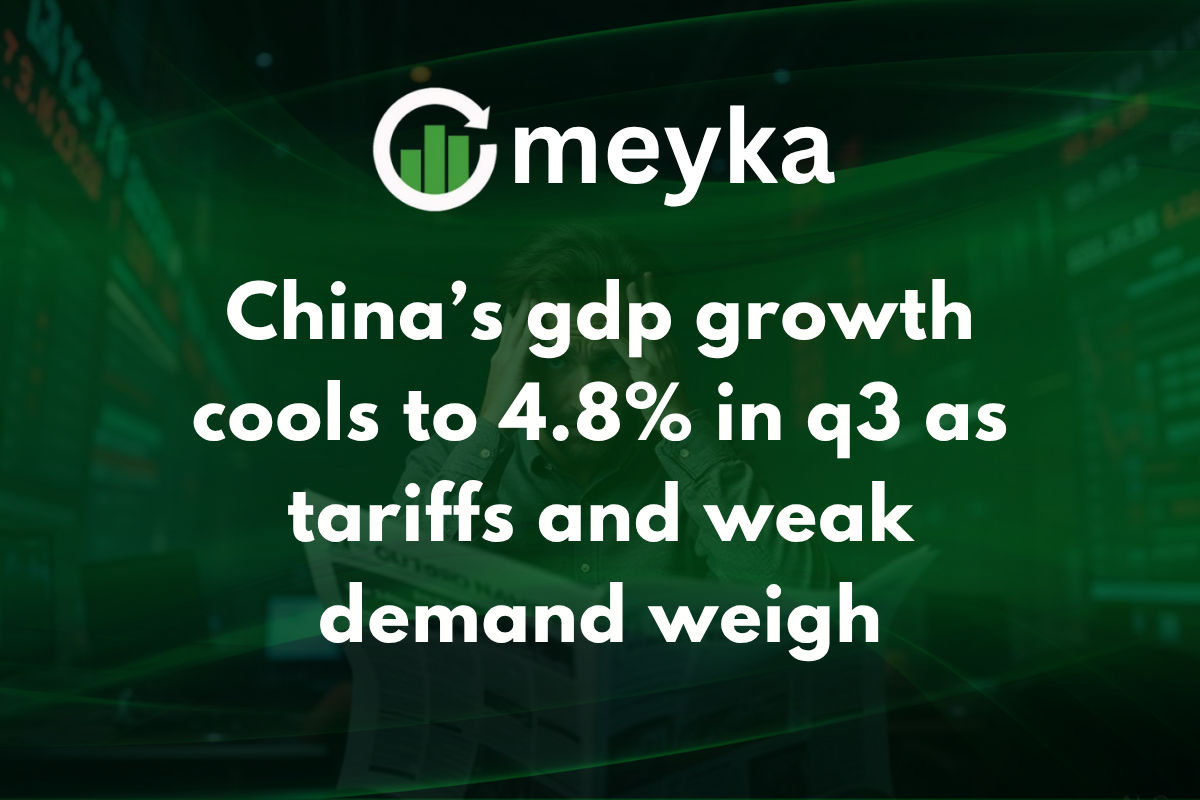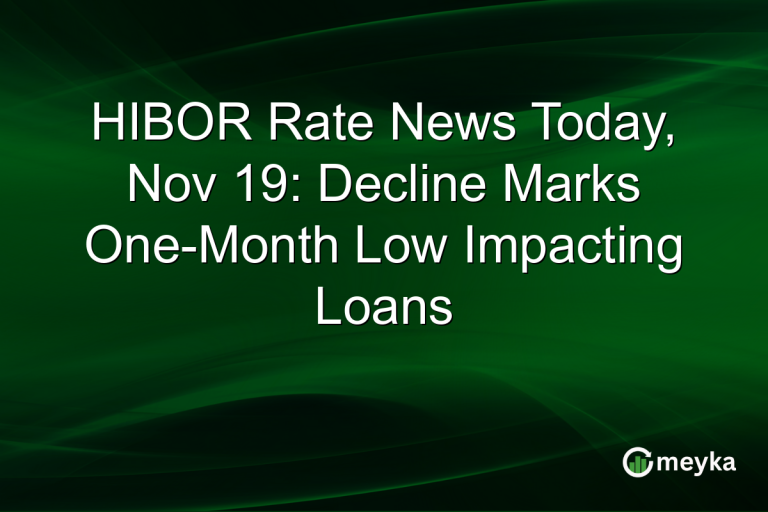China’s GDP Growth Cools to 4.8% in Q3 as Tariffs and Weak Demand Weigh
China GDP growth cooled to 4.8 percent in the third quarter of 2025, a worrying drop from the 5.2 percent pace in Q2. The official National Bureau of Statistics numbers show the weakest year-on-year growth in a year, as trade tariffs, weak consumer demand, and the long-running property slump all took a toll on the economy.
Markets and economists are watching closely, and many are calling on Beijing to roll out fresh, targeted stimulus to stop the slowdown from spreading.
What’s causing China’s economic engine to lose steam?
China GDP Growth Slows to 4.8% in Q3, Below Market Expectations
China’s July to September growth came in at 4.8 percent year on year, down from 5.2 percent in Q2, and in line with Reuters and market forecasts. On a quarter-on-quarter basis, the economy grew by about 1.1 percent, a small beat of expectations but not enough to offset the weaker annual trend.
The figures underline how the recovery is uneven, with industry and exports doing some heavy lifting while household spending remains soft.
Why this matters now
The 4.8 percent print is the lowest annual pace in a year, and it highlights structural challenges. Policymakers now face a trade-off: add short-term stimulus to prop up demand, or press ahead with longer-term reforms that may slow growth in the near term. Markets will be scanning for signs of either approach at upcoming policy meetings.
Weak Demand and Trade Tariffs Pressure China’s Economy
Two clear headwinds are visible. First, weaker domestic demand: retail sales and consumer confidence are lower than needed for a sustained, broad-based recovery. Second, trade tensions and new tariffs have reduced orders for some Chinese exporters, notably in sectors targeted by Western measures.
The Detroit News notes that tariffs and slack demand are cutting into export growth and factory orders, a fact echoed by market coverage across outlets.
Are consumers in China spending less than before? Yes, household spending remains cautious. Savings are still relatively high and rural consumption has not bounced back fully, which keeps overall demand under pressure.
Include perspective from market watchers:
“China’s Q3 GDP at 4.8% shows fading momentum. Trade headwinds and domestic caution persist, pushing policymakers toward more stimulus.”
China GDP Growth Hit by Property Sector and Investment Slowdown
The property sector remains a major drag. Property investment has fallen sharply year to date, and new home prices continued to slip, which saps buyer confidence and cuts the pipeline of construction activity that once powered much of China’s growth.
Reuters reported that property investment showed steep declines through the first three quarters, adding to the slowdown in fixed asset investment overall.
Developers, debt, and sentiment
High-profile cases of developer stress have amplified risk aversion. Liquidity problems at major developers have forced restructurings, and that has hit both construction and consumer sentiment.
This creates a feedback loop where weak housing demand drags bank lending and consumer confidence at the same time. Reuters and market analysts say this is a central reason why recovery remains patchy.
Market headline from media:
“China’s Q3 GDP misses estimates at 4.8%, dragged by property woes and trade tariffs. More monetary easing is likely in the coming months.”
Industrial Output and Retail Sales Show Mixed Signals
Not all data was negative. Industrial production showed pockets of strength, notably in high-tech and export-oriented manufacturing, while retail sales lagged. Latest monthly readings showed industrial production gains, but retail sales growth remained at a low single-digit pace.
Exports have been uneven, partly because tariffs make some goods less competitive and because global buyers are reshaping supply chains to spread risk.
Why are exports falling in some areas? Tariffs and trade frictions have made some Chinese goods more costly abroad, and buyers are diversifying sourcing to other countries such as Vietnam and India. That shift reduces orders for certain Chinese industries.
Economists Call for More Stimulus to Support China GDP Growth
With growth cooling, economists are urging Beijing to consider targeted fiscal stimulus, such as infrastructure projects, tax breaks for small businesses, and support for household incomes.
Some banks and analysts also expect further monetary easing, such as reserve requirement ratio cuts and cheaper lending for small and medium enterprises.
Reuters and market commentaries highlight that the debate is now about the size and type of stimulus, not whether some support is needed
Will stimulus measures be enough? Experts are split. Short-term, targeted measures can shore up activity. Long-term, structural reforms and stronger consumer safety nets will be needed to revive sustainable consumption.
A market check on social media:
“Stimulus talk is back on the table as GDP growth slows. Policymakers face a balancing act between stability and long-term reforms.”
International Reactions and Market Sentiment
Global markets moved on the news. Chinese equities slipped, and the yuan weakened modestly against the dollar. Investors are watching the People’s Bank of China closely for signals on policy easing.
Regional indexes also showed caution, reflecting how much Asia’s growth story ties back to Chinese demand. Yahoo Finance and Reuters coverage emphasized that the data will shape policy talk into the year-end.
How China’s Slowing GDP Growth Affects Global Trade
A slower China means less demand for commodities like iron ore, copper, and oil, which matters for big exporters such as Australia and Brazil. It also speeds up the trend of firms diversifying supply chains.
Because China still accounts for a large share of global growth, a prolonged slowdown could dampen world trade and investment. Economists warn that the ripple effects would be felt through commodity markets and regional trade flows.
China’s Long-Term Outlook
Despite near-term weakness, China remains a major global economy with plans for high-tech investment and green industry growth. If Beijing balances short-term support with reforms that boost household incomes and productivity, gradual recovery could follow in 2026.
But the road will depend on how quickly policymakers move and whether external trade tensions ease.
Conclusion
China GDP growth cooling to 4.8 percent in Q3 2025 is a clear signal that tariffs, weak domestic demand, and property sector troubles are weighing on the recovery. Short-term, targeted stimulus and easier lending may slow the slide. Medium term, China’s shift to higher value manufacturing, green investment, and reforms aimed at boosting consumption will determine whether growth regains momentum.
The world will be watching Beijing’s next moves closely, because China’s recovery, or lack of it, matters for markets and trade across the globe.
FAQ’S
According to the National Bureau of Statistics, China’s GDP growth was 4.8% in the third quarter of 2025, slowing from 5.2% in Q2. Economists view this as a sign of cooling momentum in the world’s second-largest economy.
China’s GDP growth is slowing because of trade tariffs, weak domestic demand, and a property market slump that continues to drag on investment and consumer confidence. Exports have also declined due to global trade frictions.
China’s total debt-to-GDP ratio is estimated at around 300%, including government, corporate, and household debt, according to various financial analysts. This high debt level limits Beijing’s room for large-scale stimulus.
The growth rate of China’s GDP in Q3 2025 was 4.8% year-on-year, marking the lowest pace of the year. The slowdown was mainly due to weak exports and sluggish property investment.
Disclaimer
This content is for informational purposes only and is not financial advice. Always conduct your research.






